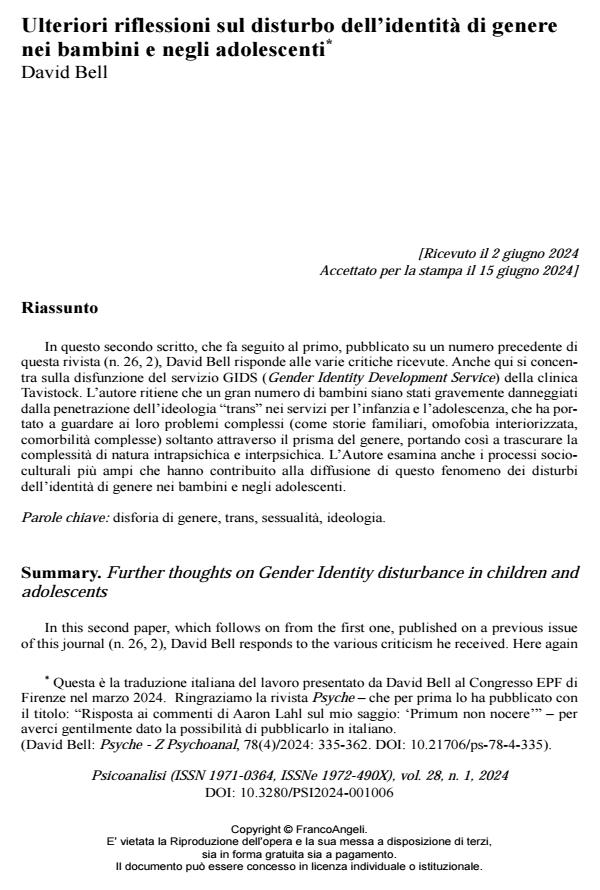Ulteriori riflessioni sul disturbo dell’identità di genere nei bambini e negli adolescenti
Titolo Rivista PSICOANALISI
Autori/Curatori David Bell
Anno di pubblicazione 2024 Fascicolo 2024/1
Lingua Italiano Numero pagine 18 P. 73-90 Dimensione file 276 KB
DOI 10.3280/PSI2024-001006
Il DOI è il codice a barre della proprietà intellettuale: per saperne di più
clicca qui
Qui sotto puoi vedere in anteprima la prima pagina di questo articolo.
Se questo articolo ti interessa, lo puoi acquistare (e scaricare in formato pdf) seguendo le facili indicazioni per acquistare il download credit. Acquista Download Credits per scaricare questo Articolo in formato PDF

FrancoAngeli è membro della Publishers International Linking Association, Inc (PILA)associazione indipendente e non profit per facilitare (attraverso i servizi tecnologici implementati da CrossRef.org) l’accesso degli studiosi ai contenuti digitali nelle pubblicazioni professionali e scientifiche
In questo secondo scritto, che fa seguito al primo, pubblicato su un numero precedente di questa rivista (n. 26, 2), David Bell risponde alle varie critiche ricevute. Anche qui si concentra sulla disfunzione del servizio GIDS (Gender Identity Development Ser-vice) della clinica Tavistock. L’autore ritiene che un gran numero di bambini siano stati gravemente danneggiati dalla penetrazione dell’ideologia “trans” nei servizi per l’infanzia e l’adolescenza, che ha portato a guardare ai loro problemi complessi (come storie familiari, omofobia interiorizzata, comorbilità complesse) soltanto attraverso il pri-sma del genere, portando così a trascurare la complessità di natura intrapsichica e interpsichica. L’Autore esamina anche i processi socioculturali più ampi che hanno contribui-to alla diffusione di questo fenomeno dei disturbi dell’identità di genere nei bambini e negli adolescenti.
Parole chiave:disforia di genere, trans, sessualità, ideologia.
- Allison S., Warin M., Bastiampillai T. (2014). Anorexia nervosa and social contagion: Clinical implications. Australian & New Zealand Journal of Psychiatry, 48, 2: DOI: 10.1177/000486741350209
- Bell D. (1997). Primitive mind of state. Psychoanalytic Psychotherapy, 10, 1: 45-57. DOI: 10.1080/0266873960070006
- Bell D. (2009). Is truth an illusion? Psychoanalysis and postmodernism. International Journal of Psychoanalysis, 90, 2: 331–345.
- Bell D. (2021). Do Not Adjust Your Set. Psychoanalytic Reflections on the Explosion in Incidence of Gender Dysphoria in Children and Adolescents EPF Bullettin 75. (trad. it. Bell D. (2022). Do Not Adjust Your Riflessioni psicoanalitiche sull’incremento dell’incidenza della disforia di genere nei bambini e negli adolescenti. Psicoanalisi. 26, 2: 37-50. DOI: 10.3280/PSI2022-002004)
- Bell D. (2021). Primum non nocere: (En premier, ne pas nuire). L’anneé Psychanalytique Internationale, 1: 39-49.
- Bell D. (2024). «Antwort auf Aaron Lahls Bemerkungen zu meinem Aufsatz» Primum non nocere. Psyche, 78, 4: 335-362.
- Becerra-Culqui T.A. et al. (2018). Mental Health of Transgender and Gender Nonconforming Youth Compared with Their Peers. Pediatrics, 141, 5:
- Bridge J. A., Greenhouse J. B., Ruch D., Stevens J., Ackerman J., Sheftall A., et al. (2020). Association between the release of Netflix’s 13 Reasons Why and suicide rates in the United States: An interrupted time series analysis. Journal of the American Academy of Child and Adolescent Psychiatry, 59, 2: 236-243.
- Campbell B. (2016). Letters. In: London Review of Books. 38, 1: 1-2.
- Dishion T. J., Tipsord J. M. (2011). Peer Contagion in Child and Adolescent Social and Emotional Development. Annual review of psychology, 62: 189-214.
- Haider A. (2018). Mistaken Identity, Race and Class in the Age of Trump. London: Verso.
- Heyman I., Liang H., Hedderly T. (2021). COVID-19 related increase in childhood tics and tic-like attacks. Archives of Disease in Childhood, 106: 420-421.
- Bell, D. (2009). Is truth an illusion? Psychoanalysis and postmodernism. The International journal of psychoanalysis, 90, 2: 331-345.
- Joyce H. (2021). Trans: Where Ideology Meets Reality. London: Oneworld Publications, p. 73.
- Kaltiala-Heino R. et al. (2015). Two years of gender identity service for minors: overrepresentation of natal girls with severe problems in adolescent development. Child Adolesc Psychiatry Ment Health, 9, 9:
- Korte A., Tschuschke V. (2023). Sturm und Drang im Würgegriff der Medien - Die Leiden der jungen Generation am eigenen Geschlecht. Zeitschrift für Kinder- und Jugendpsychiatrie und Psychotherapie. 51, 5: 351–65.
- Kozlowska K. (2021). Australian children and adolescents with gender dysphoria: Clinical presentations and challenges experienced by a multidisciplinary team and gender service. Human Systems, 1, 1: 70-95. DOI: 10.1177/2634404121101077
- Levine S.B., Abbruzzese E., Mason J.W. (2022). Reconsidering Informed Consent for Trans-Identified Children, Adolescents, and Young Adults. Journal of Sex Marital Therapy, 48, 7: 706–727. DOI: 10.1080/0092623X.2022.204622
- Littman L. (2021). Individuals Treated for Gender Dysphoria with Medical and/or Surgical Transition Who Subsequently Detransitioned: A Survey of 100 Detransitioners. Arch Sex Behav, 50, 8: 3353–3369
- Marchiano L. (2019). Transgender: The new hysteria. In: Brunskell Evans H., Moore M., Inventing the Transgender Child and Adolescent. Newcastle: Cambridge Scholars.
- Martínez V., Jiménez-Molina Á., Gerber M. (2023). Social contagion, violence, and suicide among adolescents. Current Opinion in Psychiatry, 36, 3: 237-242. DOI: 10.1097/YCO.000000000000085
- Perelberg R.J. (2018). A Psychoanalytic Understanding of Bisexuality. In: Psychic Bisexuality: A British French Dialogue. London: Routledge, pp. 1–57.
- Perelberg R.J. (2020). Sexuality, Excess and Representation: A Psychoanalytic Clinical and Theoretical Perspective. London: Routledge and New Library of Psychoanalysis, p. 33.
- Ristori J, Steensma T.D. (2016). Gender dysphoria in childhood. Int Rev Psychiatry. 28, 1: 13-20. DOI: 10.3109/09540261.2015.1115754
- Rosenthal S.M. (2021). Challenges in the care of transgender and gender-diverse youth: an endocrinologist’s view. Nat Rev Endocrinol., 17: 581–591.
- Schwartz-Mette R.A., Rose A.J. (2012). Co-rumination mediates contagion of internalizing symptoms within youths friendships. Dev Psychol., 48, 5: 1355-1365.
- Stolk T.H.R., van den Boogaard E., Huirne J.A.F., van Mello N.M. (2023). Fertility counseling guide for transgender and gender diverse people. International Journal of Transgender Health, 24, 4: 361-367. DOI: 10.1080/26895269.2023.225706
- Watters E. (2010). Crazy like us: The globalization of the American psyche. New York: Free Press.
David Bell, Ulteriori riflessioni sul disturbo dell’identità di genere nei bambini e negli adolescenti in "PSICOANALISI" 1/2024, pp 73-90, DOI: 10.3280/PSI2024-001006